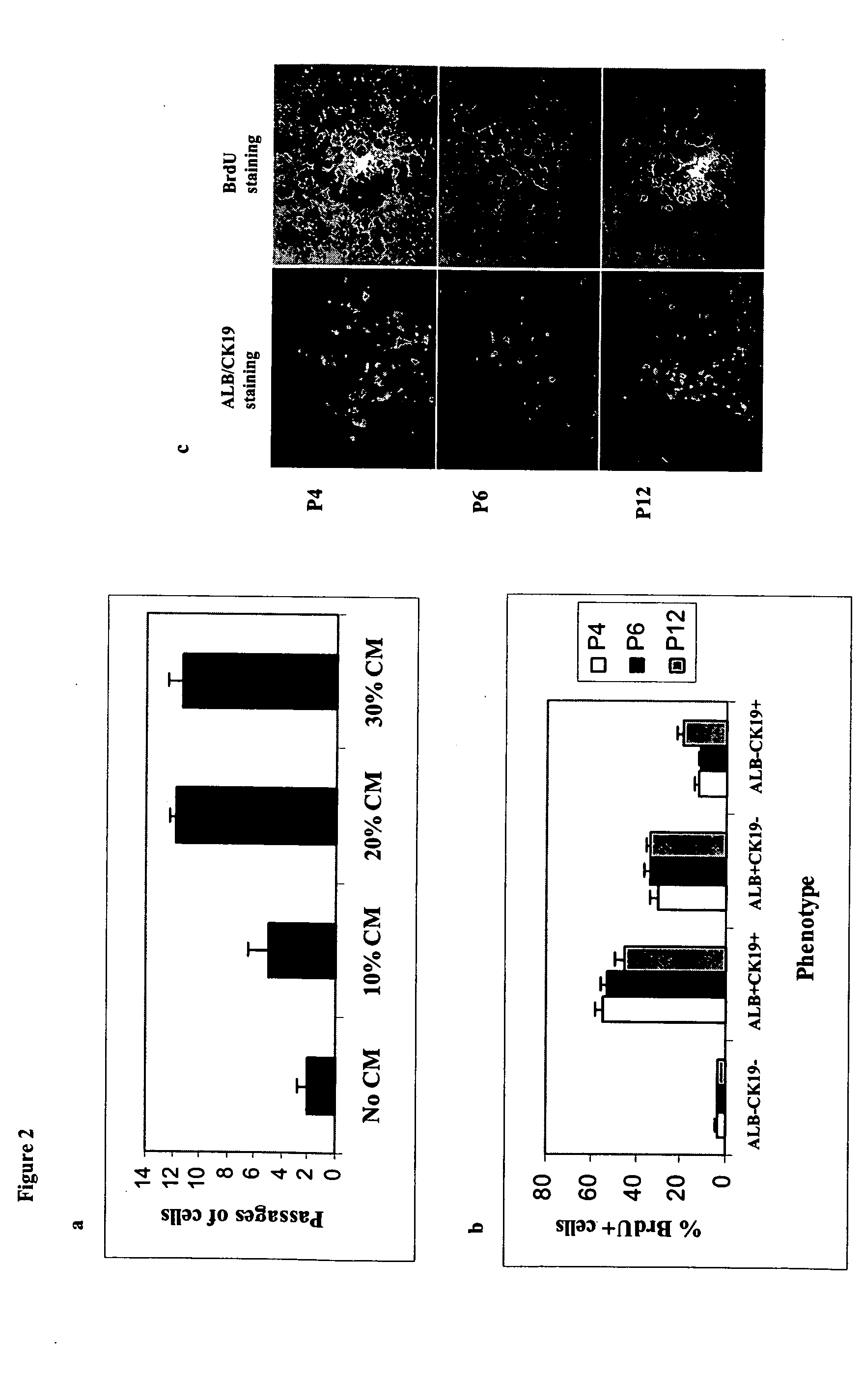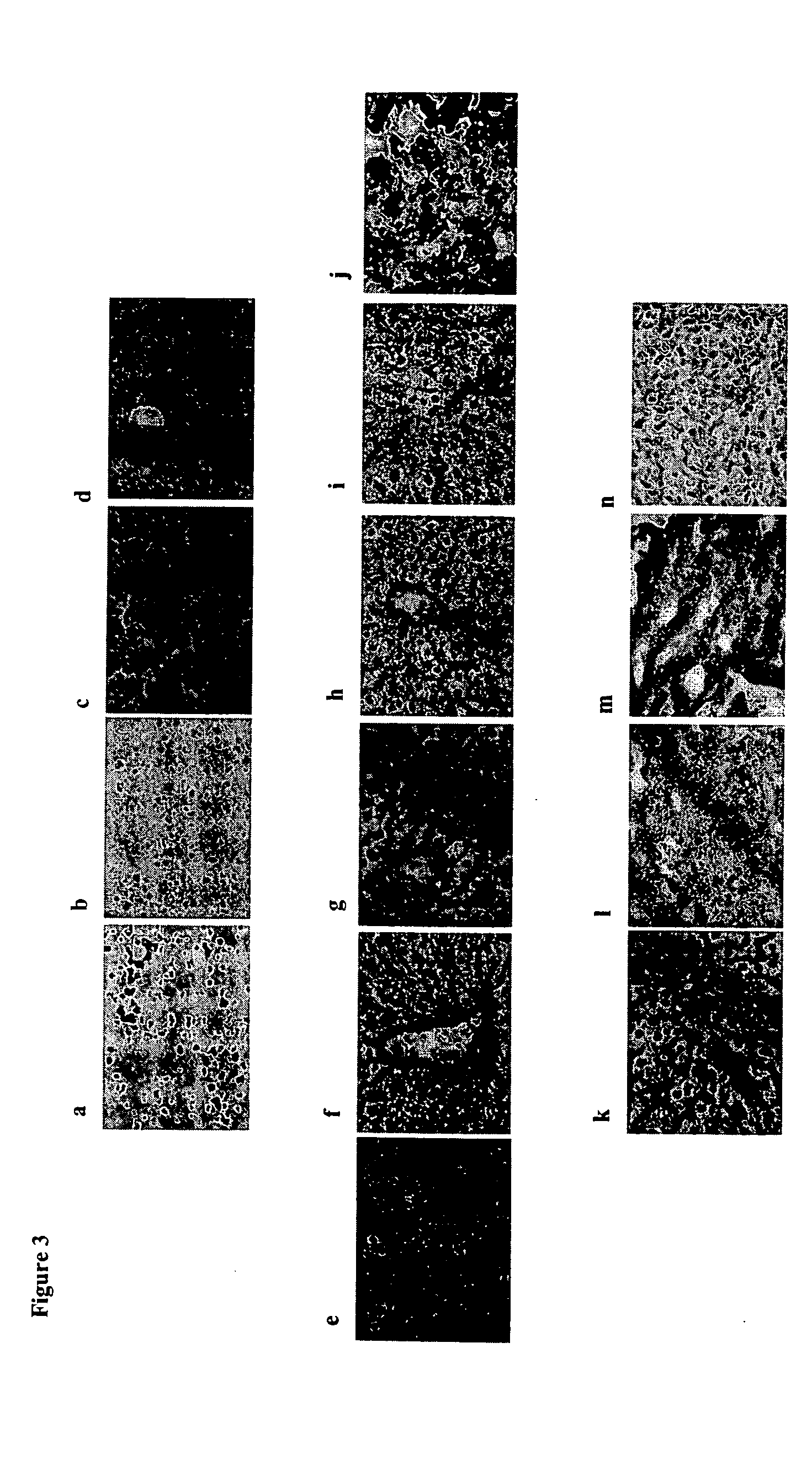Human hepatic progenitor cells and methods of use thereof
a technology of human hepatic progenitor cells and methods, applied in the field of progenitor cells, can solve the problems of high mortality, limited treatment and major advances in medical therapies, and liver failure remains acute, so as to reduce survival or proliferation, and increase the survival rate
- Summary
- Abstract
- Description
- Claims
- Application Information
AI Technical Summary
Benefits of technology
Problems solved by technology
Method used
Image
Examples
example 1
General Methods
Isolation of Human Fetal Liver Cells
[0082] Permission for the present study was granted from the local ethical committee at Huddinge University hospital. Human FL tissues were obtained from aborted fetuses at 6-9.5 weeks of gestation in accordance with the Swedish guidelines. The study protocol was approved by the local ethics committee. A modified vacuum curettage was performed (33). Gestational age was estimated according to specific anatomical markers (34) in fetuses <12 weeks of gestation and by ultrasound biparietal diameter measurements in older fetuses (35). Gestational age is given as menstrual age. The abortions were performed in pregnancies with no apparent abnormalitie, and no fetuses with anomalies were included. FL was dissected and placed in a sterile tube containing RPMI 1640 medium (Gibco, Invitrogen Corp. UK). The liver was then disintegrated into a single cell suspension by passage through a 70 μm metal mesh. The single cell suspension was centrif...
example 2
CD117+ / CD34+ / Lin− Liver Progenitor Cells Can Differentiate Into Hepatocytes And Cholangiocytes In Vitro
[0104] Using a kit designed to isolate primitive hematopoietic progenitors, a population of cells from human fetal livers (gw 6-9) were otained that that did not express any committed hematopoietic markers. Further phenotyping of this population showed expression of the stem cell markers CD117 and CD34 but no expression of liver markers such as albumin (hepatocyte marker) and CK19 (cholangiocyte marker). Nor was there any expression of Thy-1 (CD90) or CD45 (FIG. 1a). This population represent approximately 0.5%-0.7% of whole fetal livers in gestation weeks 6-9. The expressions of CD45 and CD90 were not observed during subculture of the cells. Upon cultivation, it was found these cells to be a mixture of both adherent (˜85%) (FIG. 1b) and non-adherent populations (˜15%). The non-adherent population could not be expanded further under culture conditions given below. CD117+ / CD34+ / Lin...
example 3
CD117+ / CD34+ / Lin− Liver Progenitor Cells Differentiate Into Liver Sinusoidal Endothelial Cells In Vitro In the Presence of Vascular Endothelial Growth Factor
[0105] Interestingly, when adherent CD117+ / CD34+ / Lin− cells were allowed to differentiate in culture medium containing 50ng / ml vascular endothelial growth factor (VEGF), we observed a large proportion of cells with endothelial-like morphology. Further characterization of this cell population using liver cell markers including Flk-1 known to be expressed on fetal liver endothelial progenitors, revealed four populations of cells a) endothelial cells expressing the receptor Flk-1 (˜50%), b) hepatocytes (˜13%), c) cholangiocytes (˜17%) (FIG. 1d), and d) a cell population that did not express any of these markers (˜20%) (data not shown). the sinusoidal phenotype of the Flk-1+ cells was confirmed by using a vast panel of antibodies (Table 1). Human umbilical vein endothelial cells were used to demonstrate the phenotypic differences b...
PUM
| Property | Measurement | Unit |
|---|---|---|
| temperatures | aaaaa | aaaaa |
| temperatures | aaaaa | aaaaa |
| concentrations | aaaaa | aaaaa |
Abstract
Description
Claims
Application Information
 Login to View More
Login to View More - R&D
- Intellectual Property
- Life Sciences
- Materials
- Tech Scout
- Unparalleled Data Quality
- Higher Quality Content
- 60% Fewer Hallucinations
Browse by: Latest US Patents, China's latest patents, Technical Efficacy Thesaurus, Application Domain, Technology Topic, Popular Technical Reports.
© 2025 PatSnap. All rights reserved.Legal|Privacy policy|Modern Slavery Act Transparency Statement|Sitemap|About US| Contact US: help@patsnap.com



